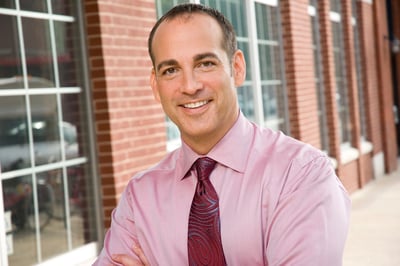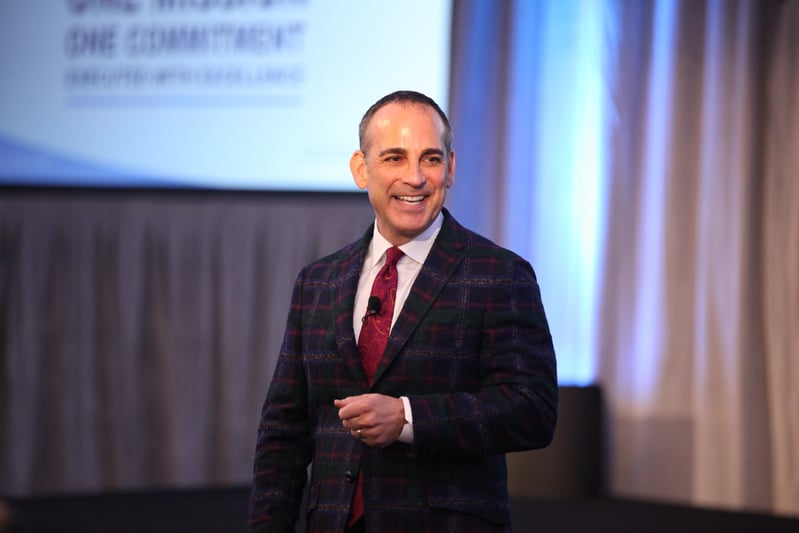Having effective internal communications tools is essential in today's workplaces, but equally as important is knowing how to best use them. Partnering with a leading communications expert can add real value.
That's why we're pleased to share an exclusive interview with renowned leadership and communication specialist David Grossman, founder and CEO of renowned consultancy The Grossman Group.

1. How did you get your start in the internal communications and leadership development space?
I worked since the day I could get a job permit because as a teenager, all I wanted was to have my own car. My friend, Richard, started working at our local McDonald’s and helped me get a job there, where I worked through high school and in the first few years of college.
I loved the structure of the job and McDonald’s commitment to standards and processes. The bucks weren’t bad, too. I could have skipped the polyester uniforms, which I think I wore in almost every color of the rainbow, including florescent green. I was promoted regularly and became a swing manager, overseeing hiring and training, which I loved. I was punching well above my weight.
I learned life skills at that job and became enamored by McDonald’s commitment to give back to the communities in which it operates. Most restaurants are owned by franchisees who live in the community and take seriously their commitment to better their community, including supporting Ronald McDonald House Charities. I liked the idea very much of doing well by doing good. While I was offered a full-time management job at my restaurant in college, I knew I wanted to get my degree. I remember saying, “I hope I’ll be back.”
At UW-Madison, I studied broadcast journalism and public relations. I thought I wanted to work as an on-air anchor and interned in a newsroom at a local station. That’s when I realized that the newsroom environment wasn’t the right fit for me. I soon realized that a job in Corporate Communications would make use of the skills I had, including my ability to ask great questions.
After an amazing first job in Corporate Communications where it felt like I did a little bit of everything, I went back to grad school, and then focused on trying to get a job at McDonald’s. I was fortunate to get a position at Golin/Harris working on Ronald McDonald House, and then helped start two new client areas – field communications and internal communications. At the same time, I was doing bench-marking with some top companies in internal communications and was taken by the potential to impact the business. Add my experience working with leaders as a journalist, and seeing the need to help them be better, and I was sold!
I helped evolve the publications function at McDonald’s into a world-class internal communications function, and knew there was potential everywhere to help leaders be better and drive business results, and of course there definitely is!
2. What are your client’s biggest pain points?
We see a number of common pain points that typically range from organizational communication not being as effective as it could be and organizations wanting to elevate internal communication. To that point, we’re also brought in to help communications’ teams break through communication clutter, when employees are bombarded with messages on various platforms and don’t know where to focus.
Separately, we see that there simply isn’t an internal communications plan in place in many organizations. It may sound basic but we often find that internal communications departments don’t have plans in place – and it shows in how the team works, how well employees are communicated with, and, in many cases, the kind of impact the function has on the business.
3. If an organization is struggling with their communication, what’s one way they can quickly become more effective?
The first and most important step is for an organization to codify what’s most important into a narrative, so everything communicated ladders up to those main messages. To do that well, it’s important to assess where you are, where you want to be and to then develop an improvement plan.
We often work with leaders and communications teams to conduct on-site communication assessments because it’s a quick and cost-effective way to level-set, identify low hanging fruit and effect change. When on-site, we discuss real-time business issues and needs and then review existing data, metrics, plans, messages and channels to see how well communication is supporting business performance.
We assess what we see against world-class attributes of great internal communication. Key attributes assessed include topics such as, messaging, planning, leader communications, two-way communication flow, channel effectiveness and more. Based on these attributes, we rate how the team’s efforts stack up so organizations know where they are on the journey to best-in-class and what to do next to improve.
From there, we often partner with and align leaders on the overall strategy for the business and arm the leaders and their teams with the tools needed to communicate in a clear and consistent way. We do this through facilitated sessions, training programs and leader toolkits geared toward an organization’s priorities and unique needs. In short, we help leaders articulate their strategy, prioritize communication and provide the skill-building needed for high performance leadership and communication.

4. Change is a constant in organizations today. What’s your advice for leaders and communications teams navigating through change and transformation?
In times of change or uncertainty, organizations need leadership more than ever. That means the quality and amount of communication need to increase. I used to work for a manager who said, “Lead, follow, or get out of the way.”
Times of change are a litmus test for leadership, which means sharing with employees what we know and what we don’t know. This is the time for courageous conversations and straightforward communication. It’s also time to talk about how our organizations are positioned for the future and/or how we’re making changes to set ourselves up for future success. Most important, this is the time to share with employees what we need from them.
Clearly, no one has all the answers. But most of us have information and perspective that will be of tremendous value to employees. We’ll never have all the answers, and if we wait, someone is going to speak for us and fill the information vacuum. Then, we have to clean up those inaccurate or toxic messages, and our work is doubly difficult.
How leaders handle uncertain times makes the difference between winning trust and meeting goals, or backtracking on hard-earned business results and repairing internal reputation.
For example, we worked with a global manufacturing company, Tenneco, who has been undergoing rapid change to accelerate growth, and has accelerated continuous improvement efforts in a variety of ways for all of its plants. Through listening sessions with executives, plant leaders and HR managers, we uncovered key manufacturing plant challenges (on top of low engagement scores), and launched an effort to share best practices, establish common metrics, and build “maturity models” to standardize operations.
As part of the continuous improvement work, leaders focused on dramatically improving engagement results from the poorest performing plants through more aggressive and focused communication with plant employees. Leadership identified 10 plants with the lowest engagement scores for the “triage” communication support. The goal was to improve engagement by 25 percent for plants selected for triage support in time for the next company full engagement survey.
Some of the key components of the communication strategy included:
-
Defined what world-class communication at Tenneco needed to look like
-
Established a plant communication “maturity model” that paved a smart path to world-class that leaders could understand
-
Developed a triage plan to assess, plan and implement special and focused communication at targeted plants
-
Established plant communication minimum requirements for leaders
-
Developed customized tools to guide how communication would occur and how it would be consistent with Tenneco’s global standards and best practices
-
Coached plant leaders on how to handle timely business communication challenges
-
Established a system to measure progress through pulse surveys at some plants and all-company surveys
-
Developed a plant communication “playbook” for all 80 plants that helped leaders meet the minimum communication requirements, which included communication for town halls, plant walk-arounds, shift huddles, and display boards
The results were extremely encouraging. All triage plants are on track to meet the goal of significantly improving engagement by the end of 2018. Some plants saw dramatic results. One East Coast plant saw a 66 percent increase in engagement scores from 2016 to 2018. Many other plants saw increases ranging from 9 percent to nearly 20 percent.
Since the launch of the triage program, other plants have asked to participate because they’ve seen the results from their peers, which we see as a true testament to the value of communications done well to drive business.
5. You mentioned you also work with senior leaders to help them be even more effective at communications. In what ways do you do that and what’s the organizational impact?
We find that having a communication “platform” can help leaders define and articulate what’s most important for them, for the organization, and for employees. Not unlike a political platform, a leadership communication platform is both a management and communication tool for leaders. It’s especially useful for those new in position, new to the company, and/or people leading organizations through significant change. The platform is designed to help leaders establish a line of sight to what they care about so employees know what’s expected and are in the best position to take action and deliver results.
In essence, it’s the core set of messages and personalized stories that capture a leader’s business goals, case for change and overall narrative along with his or her personal strengths, style, and expectations. It’s used by leaders (and their communications teams) in formal and every day communication to drive alignment and accelerate performance. For many organizations, our work supporting the communications team is directly linked to change management initiatives, and we can help maximize results for the organizational transformation work that’s underway.
6. What’s one wish you have for the communications profession in the years ahead?
I hope that communications professionals can work on the way they approach their role and elevate their leadership skills. Too often, communications leaders let themselves get pulled into the daily demands of planning communication, creating social media strategies, and supporting their own executives – all important priorities – but without taking the time to focus on their own skill set as leaders. As a result, they are not as successful as they could be in making communication a critical leadership tool that drives performance.
I think it’s natural that this happens and continuing to be better at our craft is important. At the same time, I’m concerned by it and want to see more of us break free from the routine aspects of our work and become stronger, more effective leaders ourselves. In what ways do we need to show up differently at the leadership table? How might knowing ourselves even better allow for more courageous and valued counsel? And isn’t the job of any leader really to create more and better leaders? How are we helping our team develop their skills as leaders? I see continuing to work on the craft of communication and our leadership skills a critical opportunity.
 About the author:
About the author:
David Grossman is a sought-after speaker and advisor to Fortune 500 leaders. A three-time author, David is CEO of The Grossman Group, an award-winning Chicago-based strategic leadership development and internal communication consultancy.
David is a frequent media source for his expert commentary and analysis on employee and leadership issues and his leadercommunicator blog was recently named the #1 Blog on Communication by Feedspot for the second year in a row.
Click these links to follow him on Twitter @ThoughtPartner and Facebook and to connect on LinkedIn.
